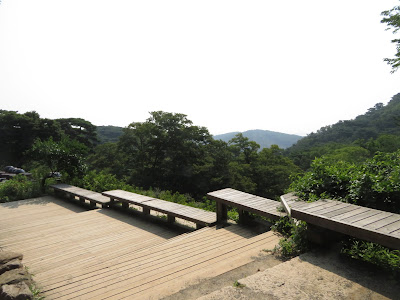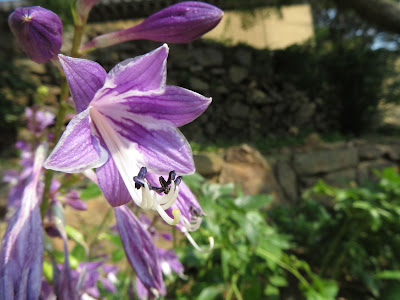Korea layover: a trip to the Jeondeungsa Temple
Are you up for a hiking trip on a really hot day, straight off a long-haul flight?
That was the tour guide's question as I signed up for a four-hour temple tour during my 12-hour layover in South Korea's Incheon International Airport. Of course I was! I definitely needed the exercise. But for good measure, I refilled my Kor bottle with water and I bought a Krispy Kreme doughnut for breakfast... nothing like a sugar rush to prepare for a bit of a walk, right?
After a one-hour bus ride, the tour guide brought us to the start of our hike in Ganghwa Island. Note that it's 9am and the temperature was already hovering in the mid 30's (Celsius). The paved road allowed cars to go closer to the temple but it's not intended for tour buses. So we had to walk starting from the bottom (aka the parking lot). It looked easy enough... until we actually started walking up.
The road slowly grew steeper as we neared the temple. It would've been a lot easier for me if I weren't carrying my handbag along. But it contained my water bottle, my food, my first aid kit (including Vicks and anti-allergy meds), my camera, my phone, and my identification documents; I couldn't leave my bag in the bus. So I just trudged along and kept smiling.
I thought we reached our destination when we reached the gate of the Samnangseong Fortress. Legend has it that this fortress was built by the three sons of Dangun, the founding father of Korea. This fortress helped protect Korea from Mongol invasions. From this point, we still had to climb for a few minutes to reach the actual temple. But aside from the temple complex, the fortress also protected the royal palace of the Goryeo Dynasty and the royal annals of the Joseon Dynasty. Additionally, this fortress was the site of Korean resistance against French military forces.
Along the way, though, I forgot the fatigue because the view became more interesting. There were several stone stacks along the path. I don't know what these structures mean; however, these stone stacks certainly require a lot of concentration and control to make... almost meditative, particularly with the ambiance of the place.
Interesting sculptures surprised me as I slowly approached the temple. Some were at the base of stone bridges.
Others were carved out of wood and were located in the garden.
And then there's the laughing Buddha welcoming the thirsty hiker to the temple complex.
I saw a worshipper drink water straight from the bamboo tube. Despite being thirsty myself and working through most of my water, I opted not to risk drinking the water because my stomach might not agree with it.
Yes, I finally reached the Jeondeungsa Temple! It's an important temple for Koreans because it is located in the birthplace of the Korean people. Jeondeungsa is the oldest temple in this part of Korea. It is also where ancestors are enshrined, which explains the presence of many white lanterns on one side of the temple.
The daejoru was an imposing building because I had to climb up its stairs to reach the main temple (behind the building). It is Incheon's Metropolitan City Cultural Material No. 7. A beautifully preserved piece of architecture.
I was amazed to see how vivid the colours were on the ceiling of the daejoru. I am not familiar with the architectural elements but I think that the red and the white details are flowers.
The wooden doors and windows give an impression that wind moves freely throughout the daejoru. It must be so cool to stay in it, even despite the heatwave I found myself in.
Further inside the temple complex, I noticed duck carvings. Do they have special meaning for the worshippers who visit the temple?
And then I saw the temple. What a sight to behold! Set amidst the lush forest, I couldn't help but stare in awe at the contrasts of the curves of the roofs and of the reds and greens of the structures. The building on the left is the Myeongbujeon (Judgment Hall).
I wanted to see the interiors of this hall so I peeped in; and what a surprise I received. I almost dropped my camera! Looking straight at me, with sword drawn, was this menacing, muscular guardian. I suppose that this was one of the Niō or Kongōrishi, guards who protect the Buddha. Behind the Niō, hanging by the ceiling, were name strips.
And then I saw stern-looking officials that reminded me of Mulan's Chi-Fu (the emperor's trusted advisor). I thought that the golden statue in the middle of these officials was Buddha, especially at first glance. However, upon closer inspection, I realised that this was different: it represented a Bodhisattva (a person on the road to Buddhahood) called Jijang Bosal. He is a very important figure in Buddhism, being the protector of children.
One of Korea's cultural treasures is the main hall, also known as the Daeungbojeon, Treasure No. 178. Built in 1621, it is one of the best examples of architecture from the mid-Joseon period (the Joseon Dynasty lasted for five centuries, starting in the late 1300s). Zooming in on the rafters on each corner of the hall, one could see that the roof's support is in the form of a naked woman. Legend has it that the artist put them there to represent a woman who rejected the master carpenter who built the hall.
There were no temple guards this time. What I first saw instead were the name strips hanging off the ceiling.
We weren't supposed to take a photo of the Buddha from inside the temple out of respect for the worshippers. So I stepped outside, stayed by the daejoru's steps and took a photo from there. This is the image of the Shaka, the historical Buddha (Siddhārtha Gautama). Flanking him are two other Buddha statues. I guess that they represent the Sanzebutsu (Buddhas of the Three Ages) in the Japanese Buddhism tradition: Amida, the past; Shaka, the present (historical Buddha), and Miroku, the future.
The Jonggo Pavilion (Drum Tower) featured wooden fish, a metal cloud, and a drum to represent the sounds of all known living creatures during the Joseon period.
Walking around the temple complex, I also noticed the symbols atop what appeared to be lotus flowers on the roof tiles. I don't know what they mean though.
Facing away from the temple halls, I noticed the mountain view. It was beautiful! Despite the heat, the forest felt lush and cool. This was a good spot for someone to have some peace and quiet before heading back to the hustle and bustle of the airport.
Aside from the greenery, I also noticed earthen pots on one side. With fermented food being an essential aspect of Korean cuisine, I could hazard a guess and say that these pots actually contain kimchi (fermented napa cabbage and other ingredients), which is believed to have medicinal properties.
Though I felt like I only scratched the surface of the history and the significance of Jeondeungsa, I had to start heading back to the tour bus because I didn't want to hurry back and miss the other sights on my walk back. That was a good idea, it turned out, because I started noticing the flowers. They seemed to enjoy the sunlight but the tour guide told me that they're "tired" because of the heat.
Nevertheless, the flowers along the path made the walk back to the bus very colourful.
As if the flowers were not enough, I even saw a squirrel! Korea has red squirrels but I'm not sure if this squirrel can be classified as such because of its fur colour (obviously not red). It actually reminded me of the black squirrel I saw in Stanford.
When I looked at the road back, I realised that we walked quite a bit in the short time that we were in Jeondeungsa. Aside from the flowers and the squirrels, I also passed by souvenir shops with colourful knick knacks.
Behind a grove of trees, I observed structures that seemed to be a pilgrimage stop. There were engravings on the vertical stone. I imagined it could be a location in In a Grove.
And as I was about to enter the tour bus, the tour guide stopped me to point to the chillies ready for the picking.
That was such an eventful trip to Jeondeungsa Temple. I was so glad that I signed up for the hiking tour despite the heat wave. I learned a lot about Korean history and culture during this stop of the tour.






























Comments
Post a Comment
Thank you for dropping by!
Before moving on, please share your thoughts or comments about the post. :)
Thanks again!